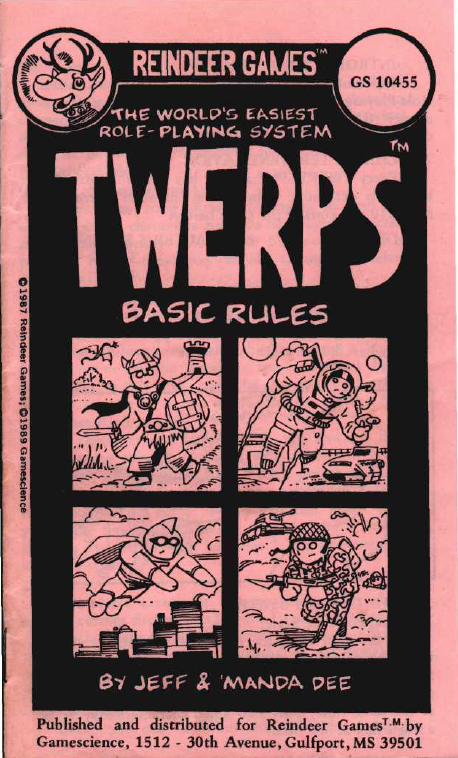TWERPS, The World's Easiest Roleplaying System by gradenko_2000
TWERPS, The World's Easiest Roleplaying System
Original SA post TWERPS, The World's Easiest Roleplaying System
TWERPS is a game written by Jeff and Amanda Lee, and published for Reindeer Games by Gamescience. The first edition of the game dates back to 1987, with later editions available as PDF scans from DriveThruRPG.
Character Generation
A player rolls a d10.
On a roll of 1, the character's Strength is 3
On a roll of 2 to 3, the character's Strength is 4
On a roll of 4 to 7, the character's Strength is 5
On a roll of 8 to 9, the character's Strength is 6
On a roll of 10, the character's Strength is 7
That's the one stat that any character has.
Basic Resolution Mechanic
Whenever a character wants to do something "too difficult to be a sure thing", they must make a Saving Roll. They roll a d10, and add their Strength. If the result is higher than a target number set by the GM, the character succeeds.
Combat - Initiative
Whoever has the highest Strength goes first. On a tie between players and NPCs, the players always goes first.
Combat - Movement
The system assumes a hex-based map, with each hex representing 10 feet, and one round representing 10 seconds. Each hex can fit up to two characters friendly to each other, and up to four characters total.
A character can move a number of spaces equal to their Strength. They can move up to twice that speed if they give up their attack (or other action) for the round.
Engaging an enemy in hand-to-hand combat means entering the same hex as them, and entering a hex with an enemy in it completely stops movement. You cannot leave the hex unless you have hit the enemy on the previous round, but were not hit back. If that happened, you can move out of the hex up to your normal speed, but you give your attack/action for the round.
Combat - Attacking and Damage
To attack a target, roll a d10 and add your Strength. The defender does the same. If your result is higher than the defender's you score a hit. A normal, bare-handed attack deals 1 damage, which reduces the defender's Strength by 1.
When a character reaches 1 Strength, they are unconscious and cannot fight, unless someone uses their action to awaken them.
When a character reaches 0 Strength, they are dead.
Equipment
Weapons can increase your chance to hit and your damage dealt. Examples from the book include a club for +1 to attack rolls and +1 to (Strength) damage, a sword for +1 to attack rolls and +2 to damage, and two-handed swords for +2 to attack rolls and +2 to damage.
Armor provides a bonus to the Strength rolls you make when defending, making you harder to hit. Examples from the book include Leather armor for +1 to defense rolls, Chainmail for +2 and Platemail for +3.
Ranged weapons are also available: a bow would have a +1 to attack rolls, +2 to damage, and a maximum range of 7 hexes (70 feet). A dagger would have no attack bonus, +2 to damage, and a maximum range of 4 hexes. A rifle might have a +1 to attack rolls, +3 to damage, and a maximum range of 10 hexes.
You cannot shoot a ranged weapon at a target in the same hex as you, and you take an attack roll penalty equal to [range to target / 3], rounded down.
Healing
After combat, any characters who are still alive may restore their Strength scores back to full. The book alludes to how you might prefer to impose some distinctions between character that have taken major wounds/injuries versus lesser ones, implying that the former should take longer to recover from and therefore longer for full Strength to come back.
Advancement
After every battle, each surviving character gains one Victory Point. A character's Strength can be increased by 1, at a cost of a number of VPs equal to the character's current Strength.
Character Customization
This is not explicitly mentioned in the book, but based on my research, most players assume that their characters have a class/profession/job, and that they are conferred a bonus on their rolls whenever that descriptor comes into play.
A game set in a Traveller-like sci-fi setting might, for example, have a Diplomat character with a +2 to all Saving Rolls involving talking to and persuading people, or an Army serviceman with a +1 to unarmed combat and physical prowess rolls, or a Pilot character with a +2 when driving a plane/spacecraft, and so on.